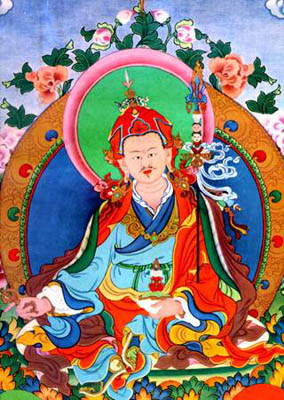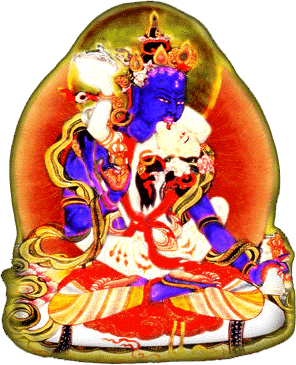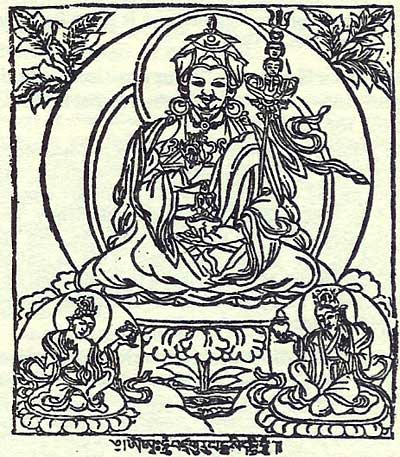
Padmasambhava
(circa 755 -797)
Padmasambhava introduced Buddhist doctrine into Tibet and exorcised its demons. He is one of the historically identifiable founders of Tibetan Buddhism and of the Lamas, as Tibetan Buddhist monks are generally called.
Padmasamhhava (literally, born of the Lotus) was born in the extreme north-west of India, now Pakistan. He was already an accredited Tantric master at the Nalanda university when he was called to Tibet by King Thn-Srong Detsan (740-786). Buddhism had doubtlessly arrived in Tibet one century before, during the reign of the first king, Tri-srong Detsan (c.610-649) who had married two Buddhist princesses, one from Nepal, and the other from China.
However, it was only under Tri-srong Detsan that the new religion began to spread. There had been no indigenous Buddhist monks in Tibet, although many visits had been made by Indian and Chinese monks from the time of King Tri-srong Detsan. King Tri-srong Detsan invited the highly educated monk Santirakshita to his kingdom, where he began construction of the first Buddhist monastery, but could not complete his task because of the interference of demons from the ancient indigenous religion. These demons were most probably the priests themselves. Santirakshita, who was a philosopher, did not have the means to fight them, and advised the king to call in Padmasambhava who was a Tantric siddha, and therefore, an exorcist.
Padmasambhava’s journey to Tibet was a triumphant march. One by one the demons were beaten and one by one they had to swear to become loyal protectors of the Doctrine. The methods of Padmasambhava ranged from the use of ritual implements such as the phurba to the mastery of the meditation techniques of dzogchen.
The Samye monastery was opened in 779, at the same time as Buddhism was declared the state religion and the first seven Buddhist monks ordained. A few years later, the last representatives of Ch’an, the Chinese school of Buddhism which had been very influential, were expelled, and the Vajrayana school, or Indian Tantric Buddhism reigned supreme.
King Srong Detsan caused two pillars to be constructed in Lhasa which contain epigrams stating that Padmasambhava’s patron was himself, Tri-srong Detsan. These
pillars are dated 783 and approximately 790. In these edicts, the word Lama does not occur, thought the kings states “by a blessing, the orthodox religion was procured”. This ‘orthodox’ or ‘inside’ religion is still the ordinary term applied to Buddhism as opposed to the Bon Religion or other faiths.
It is significant of the enthusiasm and skill imparted by Padmasambhava that seven of the first group trained by him and his deputy attained literary distinction shown in their scrupulously accurate work of translation of Indian Buddhist canons to Tibetan language. They had remarkable attainment in both Sanskrit and Tibetan languages.

Padmasambhava disposed of the antagonistic priests of the old Bön religion. In later times he was denigrated by the resentful older Bön tradition in relating his achievements. There are extant witnesses to his character that he was flagrantly magical and necromantic. Tibetan Buddhism has certain tantric elements which give rise to such tales. Ritualistic spells are also ascribed to the Buddha himself in certain 14th century manuscripts, which date from the era that ascribe similar ritualism to Padmasambhava.
After the persecution of Buddhism which accompanied the collapse of the monarchy (842), a popular form of the religion survived which remained faithful to the teachings of the Great Guru (Padmasambhava) whose writings were hidden and not discovered until several centuries later.
Padmasambhava is closely linked to the oldest Tibetan monastic order, Nyimgma-pa. In the course of centuries the figure of Padmasambhava, who continued the tradition of the maha-siddhas, took on an increasingly legendary character. Throughout Buddhist Himalaya, he is known as the Great Guru, or Precious Jewel (Lopon Rinpoche) and is worshipped as the Lama par excellence and is even considered by some to the ‘Second Buddha’. His birthday, (the tenth day of the fourth month of the Tibetan calendar (end of June/beginning of July) is celebrated with sacred dances, particularly at Hemis in Ladakh. He is the patron saint of the
Red-Hat sect of Tibetan Buddhism.
Coda

According to legend, Padmasambhava was born in the country of Urgyen in northwest Kashmir. He quickly mastered all the learned disciplines of his time, especially the teachings of the Tantras. In the 8th century he made his appearance in history through his mission to Tibet, then under the dominance of nature religion and the Bön faith. His campaign in Tibet came to an end with the construction of the Samye Monastery (775). Concerning the remainder of Padmasambhava’s stay in Tibet, the sources diverge, giving anywhere from a few months to many years.
Especially important among the teachings were the eight logos. For the benefit of future generations he also hid a great number of teachings in the form of texts (terma). The most important female student of Padmasambhava and author of his biography was Yeshe Tsogyel.
The followers of the Nyingmapa school celebrate the important events in the life of Padmasambhava (honoured as Guru Rinpoche) on the tenth day of each month. Thus on the tenth of the first month they celebrate his renunciation of the world; the second month, his ordination; on the tenth of the third month, his transformation of fire to water in the Kingdom of Zahor—and so forth. The best known invocation of Padmasambhava is that in seven lines:
In the Northwest of the land of Urgyen
On a blooming lotus flower
You attained supreme wondrous perfection.
You are called the Lotus-born
And are surrounded by a retinue of dakinis
I follow your example—
Approach and grant me your blessing.
![]()

